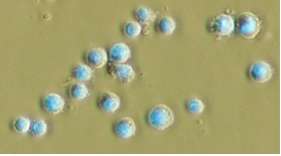Key step in allergic reactions revealed

By studying the mode of action of the interleukin-33 protein, an alarmin for white blood cells, a team at the Institut de Pharmacologie et de Biologie Structurale (IPBS - CNRS/Université Toulouse III - Paul Sabatier) has been able to evidence truncated forms of the protein that act as potent activators of the cells responsible for triggering allergic reactions. This breakthrough in the understanding of the mechanisms underlying allergy could have important applications in the treatment of asthma and other allergic diseases such as eczema and allergic rhinitis. Co-directed by CNRS researcher Corinne Cayrol and INSERM senior researcher Jean-Philippe Girard, this work is published in PNAS on 13 October 2014.
Interleukin-33 (IL-33), discovered in 2003 by Jean-Philippe Girard's team, is a protein in the family of interleukins, soluble messengers that enable communication between cells in the immune system and play a crucial role in tissue inflammation. This protein, which is stored in the blood vessels, lungs, skin or intestine, is only released in the event of cell damage. It acts as an alarmin that warns the body of trauma or infection by stimulating numerous cells in the immune system.
For several years, researchers have been trying to understand how the activity of interleukin-33 is regulated. They have now discovered that the protein is released by damaged cells and is then truncated by enzymes secreted by mastocytes, white blood cells that are key factors in allergy. By amplifying the danger signal to the immune system, these truncated forms have been shown to be 30 times more potent than the original form of interleukin-33.
The scientists have demonstrated that this highly potent signal is able to alert cells related to lymphocytes, group 2 innate lymphoid cells (ILC2). By triggering the chain reactions responsible for the allergic symptoms of asthma, eczema or allergic rhinitis, these cells have an essential role in allergy.
For the research team, preventing production of the truncated forms of interleukin-33 in order to reduce the allergic reactions triggered by ILC2 represents a promising strategy for the treatment of asthma and other allergic diseases.
More information: "The central domain of IL-33 is cleaved by mast cell proteases for potent activation of group 2 innate lymphoid cells." E. Lefrançais, A. Duval, E. Mirey, S. Roga, E. Espinosa, C. Cayrol and J-P. Girard. PNAS, 2014, in press. www.pnas.org/cgi/doi/10.1073/pnas.1410700111

















